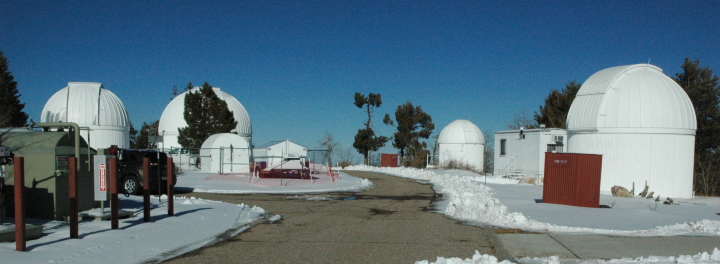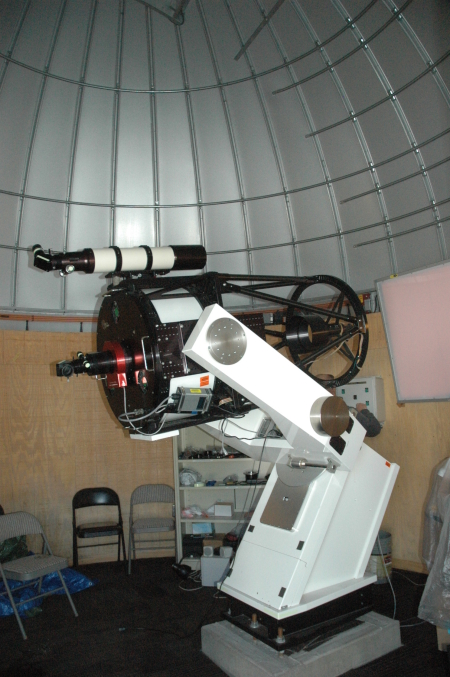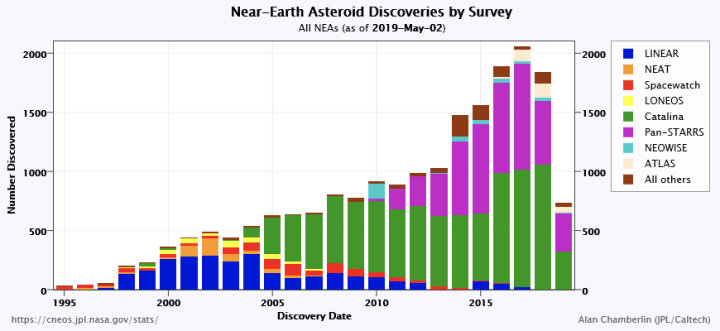The importance of small telescopes to science and civilization

Largest cluster of telescopes on Mount Lemmon, six visible with three just out of view.
On December 11, 2019 I was kindly given a personal tour by Alan Strauss, director of the Mount Lemmon Sky Center, of the telescopes located on the mountaintops of the Santa Catalina Mountains overlooking Tucson. Strauss runs the educational outreach program for the University of Arizona astronomy department and the Steward Observatory, both of which operate the mountaintop facility.
The telescopes, numbering almost a dozen, are in two groups, two telescopes on the peak of Mount Bigelow and the rest clustered on the higher peak of Mount Lemmon. None are very gigantic by today’s standards, with their primary mirrors ranging in size from 20- to 61-inches. For comparison, the largest operating telescope in the world on the Canary Islands is 409 inches across. Hubble has a 94-inch mirror. And the new giant telescopes under design or being built have mirrors ranging from 842 inches (Giant Magellan) to 1,654 inches (European Extremely Large Telescope).
Thus, the small telescopes in the Santa Catalinas generally don’t make the news. They are considered passe and out-of-date, not capable of doing the kind of cutting edge astronomy that all the coolest astronomers hunger for.
Yet, without them, we likely would not have future astronomers. “A graduate astronomy student is probably not going to get time on the big telescopes,” explained Strauss. “These are the kind of telescope they can get time on.” Universities in turn use these telescopes to train future astronomers by giving them the opportunity to do real research on a professional-class telescope.
As such, on Mount Lemmon there are telescopes run by universities in Minnesota, Florida, Tennessee, and even South Korea, several of which make their observing time available to other universities as well.
The Sky Center does its part by operating its own educational and outreach programs. First they run regular nightly programs for anyone who wishes to visit the site. Each program includes a simple dinner, a lecture, a tour, and a chance to see a bunch of beautiful astronomical objects through a large professional telescope.

The Sky Center also runs a program where local elementary and high school students spend from two to four days on the mountain, studying all kinds of science while also putting together their own research projects.
The scope to the right, the Phillips 24-inch, is ideal for this program because it is quite simple to use. “It uses a virtual sky map on a computer screen,” explained Strauss, “The kids look and say ‘What’s that?”, click on it, and send the telescope to it. That’s incredibly empowering.”
The program also takes advantage of the presence of Arizona university students doing observations to help teach and inspire the grade-school children that come up to the mountain. “That is such an eye-opener for the kids,” he explained. “A graduate student, only a few years out of high school, can say, ‘It was like yesterday that I was you, and now I’m doing this! Let me show you a picture of a star exploding that I just took!'”
And while the Santa Catalina telescopes might be relatively small and are mostly devoted to education, they also are making a significant contribution to asteroid research, a contribution that might someday actually save a lot of lives on Earth. Using the 61-inch, 60-inch, 40-inch, and 30-inch telescopes on both Lemmon and Bigelow, the Catalina Sky Survey is one of ten different projects over the past few decades that have focused on locating all potentially dangerous Near Earth asteroids (NEAs) that might someday impact the Earth.
The graph above shows all the NEAs found since these surveys began in 1995. If you look close, you will notice that, since its inception, the Catalina Sky Survey has consistently found the majority of new NEAs each year, even though many of the other surveys use bigger telescopes and more sophisticated software. Strauss explained, “These guys are better, and the reason they are better because it is people looking at data, not an automated survey operated by a computer. Human judgment is better.”
For example, on a typical night the 60-inch survey telescope will spot about 3,000 objects. Software generally identifies all but about two dozen that are already known objects or phenomenon. At that point the night’s observer will manually go through those objects to find the new NEAs, usually about two or three per night.
The result is that of the three asteroids so far discovered in space that are known to have subsequently impacted the Earth, all were found by Catalina, and all three were found by the same observer, Richard Kowalski.
Almost certainly there will come a time in the future that a very large bolide will be discovered by these surveys, just prior to hitting the Earth. The odds are very high that it will be an observer at Catalina, using these passe small telescopes, who will make the discovery. That find will then make it possible to announce a warning. If the impact is headed toward the ocean, shoreline communities can be warned of a possible tsunami. If the impact might produce a shockwave that can break glass, residents can be warned to keep away from their windows and thus avoid injury from flying shards.
And most important, in the long run these small telescopes might someday find that giant asteroid heading towards Earth that needs to be stopped, and make that discovery early enough so that we will have enough time to plan a mission to do so.
Though I have written about this previously, what this tour of the Santa Catalina telescopes reaffirmed is that smaller and older telescopes should never be abandoned or thrown away. They are valuable, and can still make a significant contribution to civilization.
Nor am I the only one who acknowledges this fact. Several of the telescopes at this facility are named after some benefactor (Schulman, Phillips) who also recognized their value, and donated the funds to keep the telescope in operation.
Astronomy (and small telescopes) need more such benefactors. The facilities benefit our culture, increase knowledge, and most important, might someday also save us from destruction.
On Christmas Eve 1968 three Americans became the first humans to visit another world. What they did to celebrate was unexpected and profound, and will be remembered throughout all human history. Genesis: the Story of Apollo 8, Robert Zimmerman's classic history of humanity's first journey to another world, tells that story, and it is now available as both an ebook and an audiobook, both with a foreword by Valerie Anders and a new introduction by Robert Zimmerman.
The print edition can be purchased at Amazon or from any other book seller. If you want an autographed copy the price is $60 for the hardback and $45 for the paperback, plus $8 shipping for each. Go here for purchasing details. The ebook is available everywhere for $5.99 (before discount) at amazon, or direct from my ebook publisher, ebookit. If you buy it from ebookit you don't support the big tech companies and the author gets a bigger cut much sooner.
The audiobook is also available at all these vendors, and is also free with a 30-day trial membership to Audible.
"Not simply about one mission, [Genesis] is also the history of America's quest for the moon... Zimmerman has done a masterful job of tying disparate events together into a solid account of one of America's greatest human triumphs."--San Antonio Express-News



Excellent piece.
One of my fondest memories during a public observation with the local club was a night I attached a simple B/W video camera to my 10″ SCT and displayed the Moon on a small screen. Primarily to highlight a few points of interest along the terminator, giving me a chance to show and explain to several folks at the same time. When the kids watched me slew the scope with the hand controller, that became the center of attention. Quickly a line formed for a chance to “drive across the Moon”. Parents also enjoyed the chance to operate the scope, instead of simply peaking in the eyepiece.
What started as a whim became another avenue to enhance the public’s understanding of telescopes and astronomy. By allowing the kids/parents a chance to touch and operate a “real telescope”, the mysteries of the night sky suddenly were within reach. So, size does not matter as much as access to the equipment.
Jeff-
Good stuff!
Mr. Z.,– you have any stats on the number of astronomy-clubs, active in the country?
Jeff “So, size does not matter as much as access to the equipment.”
Absolutely!
Several amateurs in the Rodeo NM area donate time to differing universities, allowing grad students to obtain data. I have suggested to some involved in projects to spring for a spectrometer, or a photometer to enhance their telescopes.
wayne – Sky and Telescope has a search page for clubs and activities.
https://www.skyandtelescope.com/astronomy-clubs-organizations/
Pick your state and search. I assume that like the clubs here in NC, most will have a core of dedicated members with general membership participation and interests fluctuating.
Jeff–
Thanks for that link. You have any numbers? I’m old enough to remember when owning a telescope was a big deal, and Astronomy was actively pushed in our educational system.
[You might like–http://www.stargazing.net/contents.html]
We have a number of clubs Michigan (I’m on the SW Michigan coastline) Our local club recently upgraded their dome & clubhouse, where they have 2 scopes, a 14 & 12 inch. Public outreach is always a chore for them. (they have about 50 members but only about 6 people run the whole show.)
On the upside– they are partnered with the local Community College, so if you take an Astronomy Class it does involve using an actual telescope.
The largest telescope available to the general public is in Brazos Bend Park outside of Houston TX.
An Observation–
…and that telescope would be, what size?
Remember when Hubble was sending back all those pictures of nebulas and distant galaxies all the time
Mr Zimmerman – Great piece. Outstanding site. I would like you to consider being a guest on my radio show, Task Force Gryphon on KGRA Radio, to discuss this, your work, and maybe generating some great support. The audience to TFG is “the greatest on the planet” and it will put some positive attention on your work.
I found it interesting from your comment on the John Bachelor show that the astronomer that found the asteroid that ultimately impacted the earth, that he now has a piece of it. That is following through on a project.